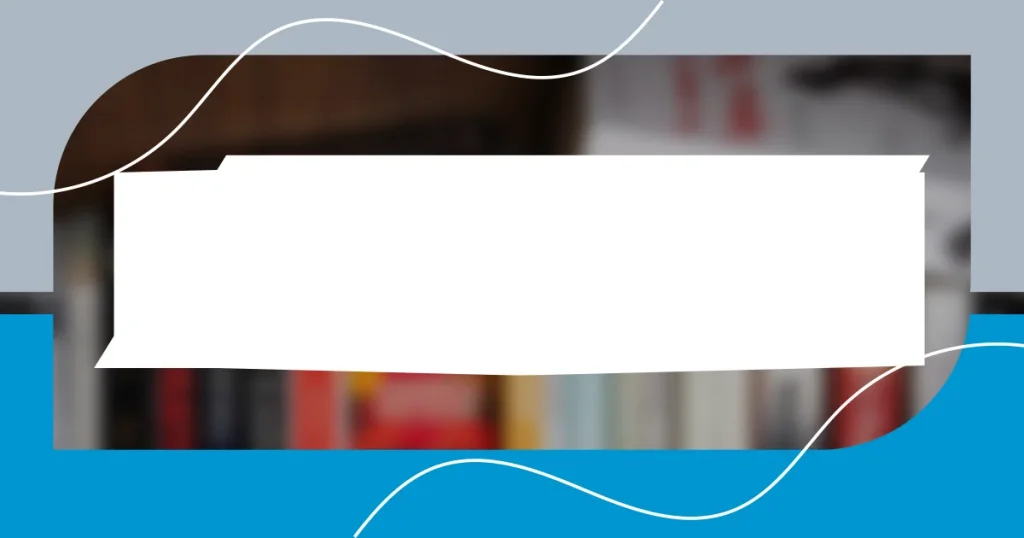Key takeaways:
- Effective horror writing explores relatable human fears, relying on character development, pacing, and atmosphere to evoke genuine emotions.
- Creating tension and suspense involves techniques like foreshadowing, uncertainty, immersive sensory details, and intimate perspectives to enhance reader engagement.
- A compelling conclusion in horror should resonate with readers, leaving lingering feelings of unease while offering resolution or intentional ambiguity.

Understanding the Horror Genre
When I first dipped my toes into writing horror, I quickly realized that it’s not just about scaring your readers; it’s an exploration of the human psyche. What truly haunts us? It’s the fears that lurk beneath the surface, often more unsettling than any monster we can conjure. I remember a time when I wrote a short story inspired by my childhood fear of the dark, and the response was overwhelming. Readers connected with those deeper emotions, proving that horror is about tapping into relatable fears.
Understanding the horror genre requires grasping its roots in suspense and tension. I learned that effective horror relies heavily on atmosphere, gradually building unease rather than relying solely on jump scares. Think about a tense moment in your own life—did the fear come in sudden bursts, or did it creep up on you slowly? For me, it was that feeling of being alone in an empty house, where the silence itself felt alive, a tension that I aimed to replicate in my writing.
Themes like isolation and existential dread frequently reemerge in horror narratives, resonating deeply with audiences. I’ve often wondered why certain stories stick with us, long after we’ve finished reading. Perhaps it’s because horror reflects our darkest truths, revealing vulnerabilities we prefer to keep hidden. When I crafted a story around the fears of losing control, I realized how powerful it was to portray these dilemmas—transforming raw emotions into chilling narratives that linger in the mind.

Elements of Effective Horror Writing
Effective horror writing is grounded in the ability to evoke genuine emotions, and I’ve found that character development plays a pivotal role in this. The reader must care about the characters to feel scared for them. I’ll never forget writing a piece where my protagonist faced their greatest fear—abandonment. I noticed that the more vividly I painted their backstory, the more my readers invested their feelings into the character’s fate. It reminds me that in horror, the stakes aren’t just life and death; they’re about emotional survival.
Another crucial element is the careful use of pacing. I often find that slow builds of tension can lead to a more substantial payoff than a quick shock. I recall drafting a scene that slowly unraveled—a family dinner that took a sinister turn. Each word, each pause, heightened the sense of dread. This technique of stretching time made readers sit at the edge of their seats, revealing how suspense can be more terrifying than the unknown lurking in the shadows.
Moreover, setting establishes an essential tone in horror narratives. A well-crafted environment can become a character in itself. When I set my story in an abandoned asylum, I infused details that made the atmosphere come alive—the peeling paint, the unsettling silence. Readers often share with me how such vivid settings transport them, enhancing the eeriness and immersing them into the world of my story.
| Element | Description |
|---|---|
| Character Development | Creates emotional investment; readers feel fear for relatable characters. |
| Pacing | Balances tension; slow builds can heighten anticipation more effectively than quick scares. |
| Setting | Develops atmosphere; a vivid environment can amplify dread and immersion. |

Creating Tension and Suspense
Creating tension and suspense is an art form that demands precision and an understanding of psychological triggers. One technique I’ve found particularly effective is revealing information in layers. For instance, when I wrote about a character hearing whispers in the dark, I didn’t immediately explain their source. Instead, I let the whispers be a mystery for a while, giving readers just enough to feel intrigued and anxious. It’s like standing in a dimly lit room—every shadow holds potential danger, making anticipation swell with each heartbeat.
To evoke that spine-chilling feeling, consider these techniques:
- Foreshadowing: Subtly hint at future horrors to make the reader uneasy about what’s to come.
- Uncertainty: Keep characters and readers questioning what’s real. I had a character doubt their sanity, and as a result, my readers grappled with doubt, too.
- Ticking Clock: Introduce urgency through time constraints, making readers anxious about the outcome. I once crafted a story where a character had to escape a haunted house before midnight—a simple concept, but it ramped up the tension tremendously.
- Intimate Perspective: Write from a close third-person point of view to allow readers to experience the character’s fear firsthand. I often found myself immersing deeper into my protagonist’s thoughts during terrifying moments, which heightened the connection and fear.
- Sensory Details: Use vivid descriptions to bring tension to life, like the cold, clammy fingers of fear wrapping around the characters. I remember describing the sound of creaking floorboards—it became like a character itself, creating anxiety with each step.
These elements can transform an ordinary story into a nerve-wracking journey, leaving readers breathless and begging for more.

Building Compelling Characters
Crafting compelling characters in horror isn’t just about their actions; it’s about their inner demons. I remember a story I wrote where the antagonist was a former child prodigy, and their genius became their curse. As I explored their psyche, I realized that readers felt a unique blend of sympathy and dread. By giving them relatable flaws, I helped readers connect with this character on a deeper level. After all, isn’t it often our own fears and insecurities that terrify us the most?
Character backstories are vital in horror—it’s where the real darkness often lurks. I once developed a character who had survived a traumatic event in childhood. As I unfolded their history, I found that readers were more invested in their struggle against the horror in the present. Each flashback added layers, creating empathy while amplifying the looming threat. By digging into their past, I reminded myself that understanding our characters’ motivations makes their challenges resonate more powerfully.
I’ve learned that the relationships between characters can amplify horror significantly. Take, for example, a mother and child scenario in one of my stories where the mother is haunted by her own failures. The tension escalated not just from the supernatural elements but from how the mother’s guilt influenced her actions. I found myself asking, how do we confront our own failures in the face of something terrifying? This interplay invited readers to engage emotionally, enhancing the horror as they rooted for the child’s safety while grappling with the mother’s internal struggle.

Using Atmosphere and Setting
Using atmosphere and setting in horror writing can be incredibly potent. I recall one chilling scene I crafted in a dilapidated old house, where the peeling wallpaper seemed to whisper secrets of the past. By immersing the reader in the setting and infusing it with discomfort, I found that the mood itself became a character—creating a visceral reaction that heightened the story’s stakes.
Weather can also play a pivotal role in setting the atmosphere. I once used a relentless storm as a backdrop for a haunting tale, with thunderous roars echoing the tumult in the characters’ lives. This deliberate choice made me realize how the environment interacts with the characters. It’s as if nature itself was an uninvited guest, amplifying their fears. Have you ever noticed how a thunderstorm feels more dramatic when you’re already stirred up inside?
Finally, incorporating sensory details—from the musty smell of an abandoned cellar to the flickering light that dances with shadows—can transport readers right into the scene. I enjoyed describing how the cold air of an empty room sent shivers down my character’s spine, making the hair on the back of my neck stand up as I wrote. These rich descriptions not only flesh out the setting but also evoke emotional responses, pulling readers deeper into the eerie world I was building. How do you think a well-crafted setting can make the terror feel more tangible and real?

Incorporating Fear Techniques
Incorporating fear techniques is essential for crafting an immersive horror experience. I once experimented with the concept of “anticipation” by withholding the reveal of a creature for as long as possible. As the tension built, readers shared in my character’s dread. Isn’t it fascinating how what’s left unsaid can often be more frightening than what’s shown?
Another effective technique I’ve found is the use of unreliable narration. In one of my stories, I narrated from a character who was slowly losing their grip on reality. Readers were drawn into the confusion, feeling the unsettling blur between what was real and what was imagined. This approach challenged me to think about how fear can stem from our own perceptions—not just from external threats. How often do we become prisoners of our own minds?
Moreover, the power of sound can’t be overlooked. I vividly remember honing in on the creaky floorboards of an old house, using them to enhance a pivotal scene. That subtle, ominous noise became a character in its own right, echoing the unease in the air. I’ve learned that sound can create a spine-chilling atmosphere, turning even the mundane into something terrifying. Have you ever felt a shiver run down your spine just from a sound in the dark? That’s the kind of visceral reaction I strive for in my writing.

Crafting a Satisfying Conclusion
Crafting a satisfying conclusion in horror writing is about delivering a resolution that resonates after the final page. I recall concluding a story in a way that left an unsettling echo, where the main character’s final choice mirrored their deepest fears. This ending not only tied up the plot but also lingered in readers’ minds, making them reflect long after they’d closed the book. Have you ever finished a story and felt the need to ponder what it all truly meant?
Moreover, it’s crucial that the conclusion raises the stakes for the characters while providing a sense of closure. In my experience, ending on a note of uncertainty—like a door left ajar or a shadow moving in the corner—can amplify that haunting feeling. I once wrapped up a tale like this, with just enough ambiguity to keep readers questioning. I’ve learned that it’s okay to leave some threads unresolved; the thrill often lies in what the reader imagines beyond the text. Doesn’t that unpredictability add an extra layer of dread?
In essence, a conclusion in horror should compel the reader to revisit the themes and emotions explored throughout the story. I often find myself reflecting on how a well-crafted ending allows me to connect the narrative dots, making the experience richer. It’s a delicate balance—offering resolution while preserving the terror. This has always made me wonder: in horror, is it the end that truly haunts us, or does it linger in our thoughts long after?
















